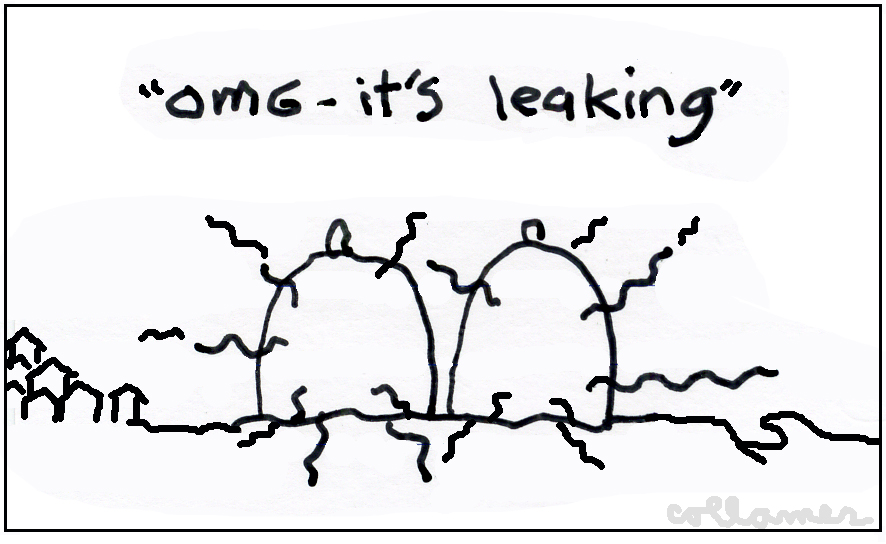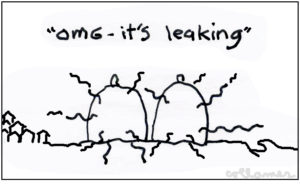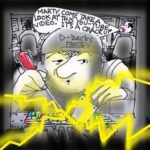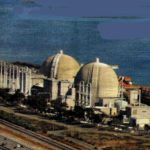An undetermined amount of radiation ‘could have’ escaped plant
By Michael R. Blood, Associated Press
LOS ANGELES (AP) — A tiny amount of radiation could have escaped from a Southern California nuclear power plant after a water leak prompted operators to shut down a reactor as a precaution, but plant workers and the public were not endangered, officials said Wednesday.
While the leak wasn’t large enough to require the plant to declare an emergency, any possible leak of radiation into the atmosphere is rare. Also concerning was that “many” tubes that carry pressurized radioactive water were damaged, according to a spokesman for the Nuclear Regulatory Commission.
The tubes are part of equipment that is virtually new, having been installed in 2010.
“The damage that they have found to many other tubes is unusual, and they are attempting to identify the reason,” NRC spokesman Victor Dricks said. He small amount of radioactive gas “could have” escaped from a building that houses auxiliary equipment.
Update from Gary Headrick, San Clemente Green:
A manager from San Onofre shared his insights with me today into what he believes is going on with the leak at the plant right now. He is very disappointed and frustrated with the way things have changed over the past few years. Decisions used to be made on a very conservative basis. Now they downplay every potential hazard leaving much uncertainty about what dangers we actually face.
Cost to Ratepayers. He is also upset that they are having leaking tubes in the generators that are less than one year into production. If one new generator has begun to leak, what is to keep us from expecting problems with the other three generators recently replaced for a cost of over $800 million? If you remember, huge holes had to be cut into the containment domes to allow the new generators to be installed.
On top of that expense ratepayers must bear, there will also be huge amounts of revenue lost due to the shutdown which is certain to take some time to repair. First things must cool off enough to work on the generator. Then the bad tubes must be isolated and sealed off. The fact that the other reactor is shutdown for routine maintenance makes re-starting even more difficult and time consuming. According to him, one reactor is left running at all times so it can assist the other one when it is starting up.
Contamination? Most alarming of all is the contamination factor. When a tube leaks, the closed loop system has been compromised. Radioactive water mixes with clean water used for steam generation. In order to shut down the system the steam must be released into the atmosphere. How much radioactivity is released depends on how much the tubes have been damaged. He compared the situation to Three Mile Island when they had to release steam from containment into the surrounding population. We have no independent radiation monitoring systems in place so there is no way to be sure about anything unless you blindly trust the industry who has much to lose if there is any bad news to report. We also need to have regular samplings for epidemiological studies to know if there are any patterns of illnesses to be aware of.
He’s not sure how much contamination may have been released. He thinks it is probably a small amount, but you never know because they “downplay the Hell out of anything like this”. We’ll probably never know for sure. Although he is loyal to the company and proud of much of the work being done there he says that management continues to claim that things are getting better there when they are not. The Nuclear Regulatory Commission is in a tough spot too. When things do not improve after years of oversight by the NRC, then they become anxious to find any sign of progress they can report on so it looks as if they are being an effective regulator.If it was up to him, he’d shut it down, but not before they have somewhere to take the radioactive waste. He’s convinced that if they leave it on site while the power plant is idle it just wont be getting the proper attention and maintenance.
Clean, Safe and Sustainable Alternatives? With all the expense and risk to over 8 million people, isn’t it about time to move on to truly clean, safe and sustainable solutions? How much longer will we allow this private enterprise continue to take millions of dollars a day in profit while putting all of the risk on us?
-Gary Headrick, San Clemente Green
Continued from the Associated Press
News of the possible release of radioactivity was slow to emerge. Shortly after the incident, Southern California Edison issued a statement saying, “There has been no release to the atmosphere.”
On Wednesday morning, however, NRC spokesman Victor Dricks said a small amount of radioactive gas “could have” escaped from a building that houses auxiliary equipment.
When asked, Southern California Edison spokesman Gil Alexander did not directly address why the plant used the language it did. He emphasized the relatively minor nature of the incident.
“I can’t speak for the NRC but we would agree that there might have been an insignificant or extremely small release,” Alexander said. He said the amount might not be detectable by monitors.
Dricks agreed, saying the radiation “would not pose a danger to anyone.” The NRC was evaluating the plant’s response to the leak, he said.
In November, nuclear watchdog and environmental groups criticized plant operators for taking more than an hour to notify the public of an ammonia leak in a storage tank that prompted the evacuation of some workers. There was no danger to the public, the company said at the time.
The Unit 3 reactor returned to full power in February 2011 after it was refueled and its two aging steam generators were replaced. The plant’s other reactor, Unit 2, had similar work. The total retrofit cost more than $670 million.
Daniel Hirsch, who lectures on nuclear policy at the University of California, Santa Cruz, said he was concerned that the problem occurred with recently installed equipment.
“Edison has historically not been candid about the problems at San Onofre. That lack of transparency causes tremendous distrust and increases risk,” Hirsch said.
“It makes one wonder about the quality assurance for the replacement equipment,” he added. “This is not due to old equipment breaking but new equipment that wasn’t up to snuff in the first place.”
The latest leak occurred in one of thousands of tubes carrying radioactive water from the plant’s reactor. The leak was initially estimated at a rate of 85 gallons a day — an amount about half of what would require the plant to shut down. Alexander said the rate of the leak was “much less,” but did not provide a figure.
It’s not clear what caused the pipe to fail, or whether the company was facing an isolated break in a single alloy tube or a manufacturing defect that might be at issue elsewhere in the massive plant tube system.
Dricks said radioactive gas that leaked from that tube in the plant’s steam generator was vented into the auxiliary building. The radiation was detected by monitors in that building, which is separate from the sealed structure that houses the reactor.
Because the auxiliary building is not sealed — people come and go through doors — it’s possible radiation escaped into the atmosphere.
Each steam generator can contain as many as 16,000 tubes, each about 0.75 inch in diameter. The hot, pressurized water flowing through the tubes heats non-radioactive water outside the tubes. The resulting steam is used to turn turbines to make electricity.
According to the NRC, the tubes have an important safety role because they represent one of the primary barriers between the radioactive and non-radioactive sides of the plant. If a tube breaks, there is the potential that radioactivity from the system that pumps water through the reactor could escape into the atmosphere.
Alexander said he could not confirm any additional damage to other tubes, pending an inspection of the equipment.
U.S. Rep. Ken Calvert, whose district includes the San Onofre plant, said his office was notified about the leak about three hours after the precautionary shutdown. The first word came from federal regulators through email, followed by the company five minutes later.
Calvert said he was satisfied with the response but was troubled by new equipment failing.
“Obviously there’s something wrong here. They need to get to the bottom of it,” he said.
The plant is owned by Southern California Edison, San Diego Gas & Electric and the City of Riverside. Southern California Edison serves nearly 14 million residents with electricity in Central and Southern California.
Associated Press Science Writer Alicia Chang contributed to this report.
Copyright © 2012 The Associated Press. All rights reserved.















NRC; it is time for States to Question your Authority
Posted on February 1, 2012 by residentsorganizedforasafeenvironment
If you have not read the ATOMIC ENERGY ACT OF 1954 (http://www.nuclearfiles.org/menu/library/treaties/atomic-energy-act/trty_atomic-energy-act_1954-08-30.htm), I would not only encourage you to do so I would ask you and your colleagues to reconsider the whole concept of giving the federal government all control and say so as to the use of nuclear energy as relates to the safety and power needs of California.
In the 1950s, nuclear was very new and not even understood correctly or completely by the experts. This is why the federal government took complete control of the entire industry. To control & produce materials needed to make weapons, to that end they sold the American public on nuclear energy as a future source of power. “Too cheap to meter “was the slogan. This has proven to be totally untrue. Now over 60 years later after much has been learned not only by the federal government but by the states who had to endure the constant radiation problems that persists at nuclear power plants that endanger the public welfare, producing on average 250 pounds per day per reactor. In America we have 5,000,000 pounds of highly toxic nuclear waste setting at our power plants. Which are licensed as “Power Plants not highly Toxic Nuclear Waste Dumps”.
Thanks so much, Gene, for your comment and all the work you do.
California voters have a rare opportunity to shut down their nuclear power plants!
Learn more here:
http://www.californianuclearinitiative.com
To learn more about San Onofre npp’s safety issues:
http://sanonofresafety.org/facts-summary/